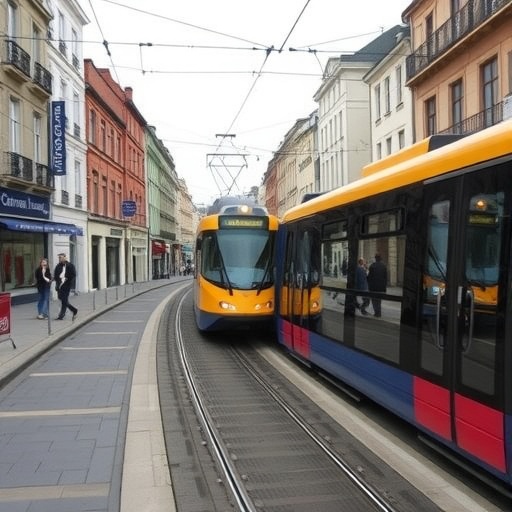The Impact of Public Transport Systems on Urban Commuting Behavior Across Europe
The commuter landscape of urban areas is one that has profoundly evolved over the decades, particularly in Europe. In a recent groundbreaking analysis, researcher Rafael Prieto-Curiel from the Complexity Science Hub meticulously conducted an examination of commuting data across 378 cities. This study identifies a direct correlation between the presence of metro systems and commuter behavior, presenting compelling evidence that could alter city planning and public transport investments for years to come.
The research highlights the multifaceted nature of commuting in urban environments, classifying daily travel habits into three distinct categories: active mobility, which encompasses walking and cycling; public transport, including metro systems, trams, and buses; and motorized private transport, involving cars and other personal vehicles. Such a categorization is pivotal in understanding the shifts in urban mobility preferences and the underlying factors that contribute to these changes.
Fascinatingly, the analysis reveals that cities equipped with metro systems experience a significantly lower proportion of car trips compared to those reliant on trams or lacking rail systems altogether. In cities with metro infrastructure, car trips constitute an average of only 37% of total commutes. In contrast, this figure escalates to 50% in cities with a tram-only network and climbs further to 54% in cities devoid of any rail transport system. This substantial divergence underscores the effectiveness of metros in curbing car dependency, suggesting a pivotal role in reducing city congestion and its associated negative externalities.
A further layer of complexity is added when examining larger cities, those with populations exceeding 750,000 inhabitants. In these metropolitan behemoths, the share of car commutes skyrockets to 63% where no metro system exists, illustrating a critical tipping point. Conversely, the car trip share in metro-dense urban environments remains stable at approximately 36%. This stability in car trips amidst city growth indicates that metro systems provide a backbone for sustainable public transport usage, fostering a transportation culture that diminishes car reliance as population densities increase.
The impact of a single metro station on commuter behavior cannot be overstated. In a hypothetical scenario, if a city with a population of one million lacks a metro system yet possesses a tram network, it could see nearly twice the number of annual car trips compared to a similar-sized city that benefits from a metro system. With approximately 370 million car trips occurring annually in metro-enhanced cities, the urgency for cities to consider investing in such efficient systems becomes abundantly clear.
Prieto-Curiel also highlights the unique case of cities that, despite not having metro systems, manage to keep car shares low through effective urban planning and strong active mobility frameworks. Examples such as Utrecht and Bern illustrate that with adequate bicycle infrastructure and pedestrian-friendly designs, car dependency can be mitigated. Meanwhile, cities like Rome exhibit counterintuitive higher car shares, even with metro systems in place, emphasizing that mere presence of transport options does not guarantee a shift away from cars.
Not just theoretical, the implications of even minor reductions in car trips manifest in verifiable benefits. For instance, an adjustment in commuter behavior in Vienna, from 27% to 26% car trip share, could result in an astonishing yearly reduction of approximately six million trips. This finding suggests a direct relationship between incremental changes in commute habits and substantial environmental benefits.
Historically, the evolution of tram systems further elucidates the subject matter. Once viewed as the transportation of choice in the early 20th century, tram networks dwindled in number with the ascendance of private vehicle ownership. However, the past few decades have signaled a resurgence of trams, particularly in European cities, highlighting their role in a balanced transport ecosystem. Despite this revival, the study indicates that trams, primarily due to their slower speeds and lesser capacity compared to metros, do not wield the same capacity to effectively decrease car traffic.
The relevance of these findings extends beyond European borders, as cities worldwide grapple with balancing urban mobility and environmental sustainability. As urban centers increasingly endorse policies aimed at bolstering public transport to alleviate congestion and diminish carbon footprints, Prieto-Curiel’s study provides critical insights. They underscore that while tram systems can play a pivotal role in enhancing urban transit options, high-capacity metro networks are indispensable for significant reductions in car usage.
The medical, economic, and social implications of a reduction in car dependency cannot be overstated. Issues such as air pollution, noise aggravation, and traffic congestion plague modern cities. By promoting expansive and user-friendly public transport systems, cities can not only address these challenges but also enhance the overall quality of urban life.
Looking forward, as cities navigate the complexities of urban mobility, strategic investment in public transport infrastructure appears to be paramount. Emphasizing systems that demonstrate high effectiveness in reducing car traffic, while considering the nuances of local urban sprawl and commuter behavior, will be crucial. Policymakers and urban planners must glean insights from studies like Prieto-Curiel’s to carve paths toward sustainable urban mobility that harmonizes the needs of residents and the environment.
Through enhancing public transport systems and advocating for active mobility options, municipalities can cultivate communities that prioritize sustainability. In conclusion, as cities evolve, the question remains: will they prioritize effective public transport systems that genuinely reduce car dependency and foster healthier environments? The evidence suggests the answer is a resounding yes.
Subject of Research: Urban commuting behaviors
Article Title: The Impact of Public Transport Systems on Urban Commuting Behavior Across Europe
News Publication Date: 07-Nov-2025
Web References: Nature Cities
References: N/A
Image Credits: Complexity Science Hub
Keywords: Urban Mobility, Public Transport, Metro Systems, Tram Systems, Active Mobility, Commuting Behavior, Sustainable Cities, Transportation Engineering, Urban Planning.




